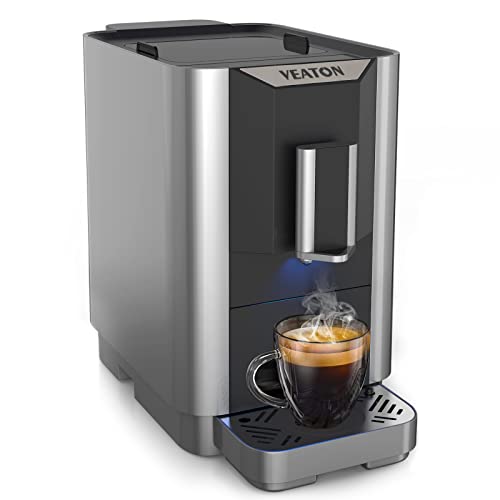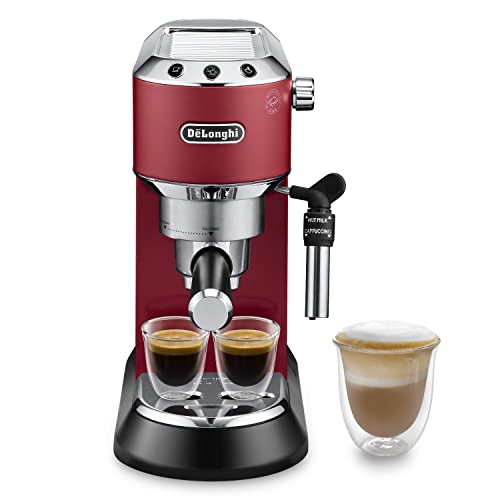8 Tips To Boost Your Coffee Machines Espresso Game
페이지 정보
Aretha Cunniff 작성일25-01-31 18:43본문
Coffee and Espresso Machines
Espresso machines make use of pressure to push water through finely ground and tamped coffee beans. They produce a rich and tasty brew.
Good Housekeeping Institute experts recommend models that are brewed at 9 bar espresso machine bars or less to ensure a perfect extraction. Beware of manufacturers that claim to use higher pressure than necessary.
Types
The electric buy espresso makers maker, your domain name, maker (also known as a coffee or Espresso maker) produces coffee that is more concentrated, and of better quality, than your favorite cafe drinks. It uses an average of nine bars of pressure. These machines have many features, including the ability to control temperature and brew strength with programmable brewing as well as multiple drink sizes. They may also come with manual or automatic steam wands to create the appearance of latte art using texturized milk. They are available in three different types of espresso machines including semi-automatic, automatic, and super-automatic models. Each espresso machine has its own degree and type of automation.
Semi-automatic espresso machines are the most sought-after for specialty coffee shops. This allows baristas to have complete control over the brewing process, however it's not as user-friendly as a fully automatic machine. To get the best espresso, you have to grind the beans, fill the portafilter and tamp it down, then alter the extraction time.
Automatic machines come with built-in mills that measure and tamp your grounds. They automatically disperse the right amount of water to make the mini espresso machine, and typically have a programmable drink size function. In our tests in the lab, they were the most sought-after type of espresso machine. They offer a great combination of consistency and manual control.
 Functions
Functions
No matter if you opt for a pump-driven machine or a steam-driven model, you'll get a reservoir that stores the water used to make your coffee. You'll also have a heating element that heats the cold water to create the intense pressure needed to extract coffee from grounds.
When the brew button is pressed to brew, the water inlet valve is closed so that only hot water under high pressure can pass through the portafilter and into the ground coffee. The water takes approximately 25 seconds to convert into espresso.
 The tubing that is insulated and referred to as the hot-water tube is affixed from the reservoir to the spout atoftener if you have hard water to prevent mineral build-up and keep your espresso fresh.
The tubing that is insulated and referred to as the hot-water tube is affixed from the reservoir to the spout atoftener if you have hard water to prevent mineral build-up and keep your espresso fresh.
Certain manufacturers employ a thermostat that is digital, integral and proportional, to ensure a certain temperature range when making espresso. This feature can ensure the same high-quality, consistent cup of espresso each time. This feature also reduces energy costs because the machine only functions when it is required.
Maintenance
As coffee and espresso machines become more accessible for use at home, the regular maintenance of the equipment becomes more essential. Having the most efficient equipment can make a world of difference in the taste of your coffee, but that's only true if your machine is working properly.
A regular cleaning and maintenance routine should include everything from cleaning the steam wand and group head, to descaling, to changing the water filter frequently. If you make between two and five cups of coffee every day, it's recommended that you clean the main components of your machine once a week. However, certain parts of the machine, like the water tank and the grinder should be cleaned every two or three months.
It is also recommended to flush the machine every week. This procedure involves locking the portafilter in place and running the brew process several times. This can help to eliminate any coffee grounds or oils left behind. You can also use a brush or cleaner made specifically for espresso machines to clean the portafilter.
Maintaining your coffee and espresso machine correctly can also ensure that it lasts longer. Many professional espresso machines in offices and cafes are costly, so it is vital to ensure that your machine is in good condition so that it can last as long as is possible.
Espresso machines make use of pressure to push water through finely ground and tamped coffee beans. They produce a rich and tasty brew.
Good Housekeeping Institute experts recommend models that are brewed at 9 bar espresso machine bars or less to ensure a perfect extraction. Beware of manufacturers that claim to use higher pressure than necessary.
Types
The electric buy espresso makers maker, your domain name, maker (also known as a coffee or Espresso maker) produces coffee that is more concentrated, and of better quality, than your favorite cafe drinks. It uses an average of nine bars of pressure. These machines have many features, including the ability to control temperature and brew strength with programmable brewing as well as multiple drink sizes. They may also come with manual or automatic steam wands to create the appearance of latte art using texturized milk. They are available in three different types of espresso machines including semi-automatic, automatic, and super-automatic models. Each espresso machine has its own degree and type of automation.
Semi-automatic espresso machines are the most sought-after for specialty coffee shops. This allows baristas to have complete control over the brewing process, however it's not as user-friendly as a fully automatic machine. To get the best espresso, you have to grind the beans, fill the portafilter and tamp it down, then alter the extraction time.
Automatic machines come with built-in mills that measure and tamp your grounds. They automatically disperse the right amount of water to make the mini espresso machine, and typically have a programmable drink size function. In our tests in the lab, they were the most sought-after type of espresso machine. They offer a great combination of consistency and manual control.
 Functions
FunctionsNo matter if you opt for a pump-driven machine or a steam-driven model, you'll get a reservoir that stores the water used to make your coffee. You'll also have a heating element that heats the cold water to create the intense pressure needed to extract coffee from grounds.
When the brew button is pressed to brew, the water inlet valve is closed so that only hot water under high pressure can pass through the portafilter and into the ground coffee. The water takes approximately 25 seconds to convert into espresso.
 The tubing that is insulated and referred to as the hot-water tube is affixed from the reservoir to the spout atoftener if you have hard water to prevent mineral build-up and keep your espresso fresh.
The tubing that is insulated and referred to as the hot-water tube is affixed from the reservoir to the spout atoftener if you have hard water to prevent mineral build-up and keep your espresso fresh.Certain manufacturers employ a thermostat that is digital, integral and proportional, to ensure a certain temperature range when making espresso. This feature can ensure the same high-quality, consistent cup of espresso each time. This feature also reduces energy costs because the machine only functions when it is required.
Maintenance
As coffee and espresso machines become more accessible for use at home, the regular maintenance of the equipment becomes more essential. Having the most efficient equipment can make a world of difference in the taste of your coffee, but that's only true if your machine is working properly.
A regular cleaning and maintenance routine should include everything from cleaning the steam wand and group head, to descaling, to changing the water filter frequently. If you make between two and five cups of coffee every day, it's recommended that you clean the main components of your machine once a week. However, certain parts of the machine, like the water tank and the grinder should be cleaned every two or three months.
It is also recommended to flush the machine every week. This procedure involves locking the portafilter in place and running the brew process several times. This can help to eliminate any coffee grounds or oils left behind. You can also use a brush or cleaner made specifically for espresso machines to clean the portafilter.
Maintaining your coffee and espresso machine correctly can also ensure that it lasts longer. Many professional espresso machines in offices and cafes are costly, so it is vital to ensure that your machine is in good condition so that it can last as long as is possible.
댓글목록
등록된 댓글이 없습니다.

















